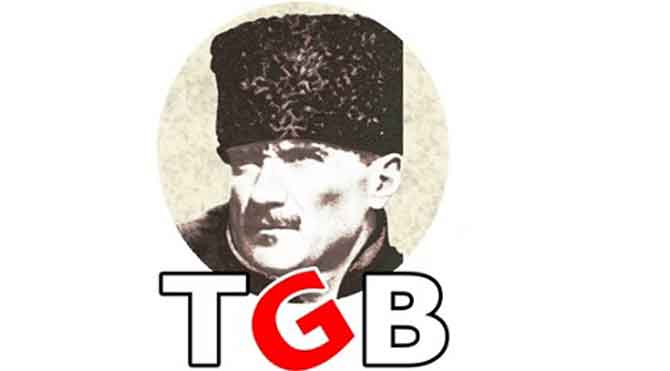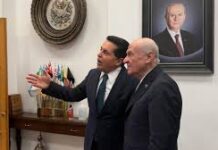In mid-April, Turkish Youth Union (Türkiye Gençlik Birliği – TGB) members somehow got themselves included in a group allowed into İncirlik AFB to commemorate an upcoming Turkish holiday. They used this opportunity to once again attempt to put hoods over the heads of US military personnel present at the ceremony (1).
Previously, the TGB had gained notoriety for assaulting several US servicemen in Eminönü, İstanbul’s central port neighborhood Eminönü. In that incident, in November 2014, the TGB members also tried to force hoods over the heads of some US military personnel. The TGB had tried the same stunt in a previous incident in Turkey’s southeastern port city of İskenderun (3).
International and English-language reports on these incidents have displayed some confusion as to how the TGB should be defined politically. This confusion is understandable because political movements in the industrializing world do not always follow the lines of politics in the industrialized countries, and especially those in Western Europe or North America. Jargon used by a political group in Turkey, for example, may be misunderstood or misconstrued by a foreign observer who isn’t familiar with the history or intricacies of domestic Turkish politics. Often, the TGB is labeled in English as “nationalist” or “ultra-rightist,” when in reality TGB members would forcefully reject such labels (4). Most members of the TGB would label themselves as Kemalist, ulusalcı (“patriotic-leftist”) or just leftist, while they would react against being called milliyetçi (nationalist). To understand how this works in ideological terms, we have to venture into some political history, involving, as E. J. Hobsbawm, a foremost historian of the 19th and 20th centuries, put it, a transformation of modification of “European Leftism as transferred to industrializing societies”:
Thus what is today called the ‘Third World’ or the ‘underdeveloped countries’ lay at the mercy of the West, its helpless victim. But did these countries derive no compensating advantages from their subordination? As we have seen, there were those in the backward countries who believed that they did. Westernization was the only solution, and if this meant not only learning from and imitating the foreigners but accepting their alliance against the local forces of traditionalism, i.e. their domination, then the price had to be paid. It is a mistake to see such passionate ‘modernizers’ in the light of later nationalist movements simply as traitors and agents of foreign imperialism. They might merely take the view that the foreigners, quite apart from their invincibility, would help them to break the stranglehold of tradition, and thus allow them eventually to create a society capable of standing up to the west. The Mexican elite of the 1860s was pro-foreign because it despaired of its country. Such arguments were also used by Western revolutionaries. Marx himself welcomed the American victory over Mexico in the war of 1847, because it brought historical progress and created the conditions for capitalist development, that is to say for the eventual overthrow of capitalism. His views of the British ‘mission’ in India, expressed in 1853, are familiar. It was a double mission: ‘the annihilation of the old Asiatic society, and the laying of the material foundations of Western society in India’. (5)
This quote from Hobsbawm explains very well the essential problem in approaching Turkish political developments over the past 200 years. The original “modernizers / Westernizers” of Ottoman society were the political elites (the bureaucracy, the officer classes, and the intelligentsia) of the mid-to-late 19th century. As Hobsbawm suggests, those Ottoman elites saw the introduction of Western technology and ideas as positive transformative forces that would break down traditional Ottoman social forms, and help bring about a state and society which could then compete with Western states and societies. And because the Ottoman masses were largely conservative, illiterate peasants, those same elites generally viewed them with condescension and distaste.
One of such members of the modernizing Ottoman elite was Mustafa Kemal, a professional career officer who, relying on the momentum and charisma provided by the victory of the National Resistance of 1919-22, went on to proclaim the end of the Ottoman dynasty, and to replace it (from 1923 onward) with the foundations of a republican system. The project then became transforming traditional Ottoman society into a modern nation-state. The guidelines, ideas, and models utilized for this project were almost entirely Western.
The ideology that eventually became associated with the Turkish nation-state project is Kemalism, which takes its name from Mustafa Kemal (Atatürk). However, Kemalism was, and is, not so much a systematic ideology as a loose collection of concepts, some receiving more or less emphasis depending on the political juncture, associated with each other largely through the personal example of Atatürk, who at the end of the day was too eclectic and pragmatic to allow himself to be tied down to a hard-core doctrine. The only real foundations for Kemalism as an ideology would be the “Six Arrows” (republicanism, statism, nationalism, populism, reformism, and secularism) codified in the early 1930s. In other words, there is no strict system or organization to Kemalism, and at any moment in Turkish society it is current opinion that has largely defined what is considered Kemalist. Moreover, clearly the “Six Arrows” are not strictly strict identifiable with any one Western political ideology. Statism, for example, is associated with socialism, while nationalism, an idea that was revolutionary in early 19th century Europe, was embraced by Western conservatives in the decades after the 1848 revolutions.
Because the Turkish Republic was established after a military struggle to eject the Entente powers (England, France, Greece, Italy) which had occupied Istanbul and parts of Anatolia after WWI, “anti-imperialism” also featured in the political rhetoric of the time. Another aspect of the same effort was Mustafa Kemal’s politically astute — and strictly short-term — friendship and aid pact with the young Bolshevik regime in Moscow.
Subsequently, when Turkey’s political system was opened to all political ideologies in the 1960s, there were elements from the Republic’s early years that leftists could latch onto in order to provide appropriate Kemalist coloring for their own political rhetoric. Furthermore, it is interesting to note that the brand of Marxism-Leninism which became more popular in Turkey during the 1960s and 70s was not the relatively staid Soviet Stalinist interpretation, but rather varieties of Maoist revolutionism, peasantism and Third Worldism because Turkey was still a largely agricultural society. In sum, nationalism with an anti-imperialist twist (or perhaps disguised as anti-imperialism) has always been a key element of Turkish leftist discourse even though in a European context it would have been associated with a fundamentally opposite Western political tradition.
For reasons that are all too clear, this same, theoretically impossible but widely practiced mix of political ideologies has marked much of the post-colonial (depending on your political correctness preferences: underdeveloped, developing, newly developing or newly industrializing) world. Marxist leftism was originally based on a class analysis of human societies, which once promoted a universalist, non-nationalist theoretical standpoint. Colonial societies’ struggle for independence took place against the metropolitan center, which meant a new politics of anti-imperialism. But in order to maintain unity both before and after independence was achieved, nationalism had to be employed because Marxism’s would-be revolutionary class, the proletariat, was a negligible part of these still largely agricultural societies. Leninism seemed to offer a way out: by arguing that capitalism had evolved into monopoly capitalism and imperialism, and that therefore imperialism was nothing but an advanced form of capitalism, so that anti-imperialism did have a class-content, and was part and parcel, indeed a key driving force, of the world revolution. Such compromises in Bolshevik-Soviet ideology justified a theoretically contradictory combination of socialism and nationalism.
This brings us to the TGB (to be continued).
NOTES
(1) http://www.dailysabah.com/investigations/2016/04/16/anti-american-tgb-activists-attempt-to-sack-us-soldier-at-incirlik-airbase-in-turkey; http://www.hurriyetdailynews.com/us-soldier-mobbed-by-turkish-nationalist-youth-group-two-detained.aspx?pageID=238&nID=97909&NewsCatID=509
(2) http://www.cnnturk.com/fotogaleri/turkiye/istanbulda-abd-askerlerinin-basina-cuval-gecirdiler?page=1; http://time.com/3582737/turkey-youths-attack-american-sailors-istanbul/
(3) http://www.turkishnews.com/tr/content/2013/01/23/alman-askerlerin-basina-cuval-gecirmeye-calistilar/
(4) http://www.nytimes.com/2014/11/13/world/europe/us-sailors-assaulted-by-turkish-nationalists-in-istanbul.html; http://www.nytimes.com/video/world/asia/100000003231358/turkish-nationalists-attack-us-sailors.html
(5) Eric Hobsbawm, The Age of Capital, 1848-1875, “Chapter 7: Losers.”













